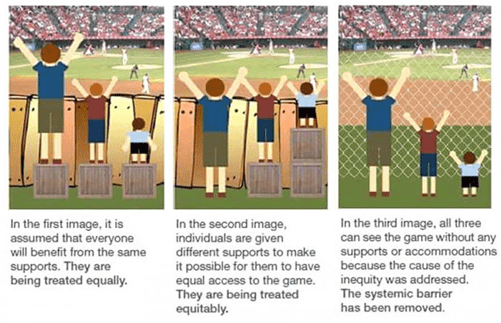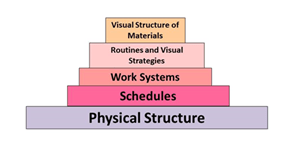
By Gail Preston
EDITION #11 – What does it mean to lead?
Published – 13th November 2019
Gail Preston is a former Principal of a Special school and now supports teachers to work
with students with additional learning needs.

Introduction
As teachers, our challenge is to lead an inclusive classroom where all children are fully engaged, all children are included and the supports for learning for every child are embedded in our everyday teaching practice. We must consider how to structure the learning environment to meet the needs of all students.
The Melbourne Declaration on Educational Goals for Young Australians (Ministerial Council on Education, Employment, Training and Youth Affairs, 2008) provides the policy framework for the Australian Curriculum. It includes two goals:
- Australian schooling promotes equity and excellence
- All young Australians become successful learners, confident and creative individuals and active and informed citizens.
Similarly, Practice Principle 2 (Department of Education and Training, 2019) calls for a supportive and productive learning environment that promotes inclusion and collaboration.
These are important goals for us to consider when preparing for every class and when we walk into every classroom.
I like to use the visual below to explain equity. We usually start with the scenario in the first image regarding our understanding of equity. Our aim as inclusive classroom leaders is, in fact, to start with image three as no barriers to learning will be present from the beginning.

Supporting students with a structured approach to teaching
The structure and organisation of a classroom are critical components in the successful academic and social achievement of all students. Creating an inclusive classroom can be a challenge for new teachers in meeting the diverse needs of students. I have found that the most effective strategy to meet the needs of all students is to adopt a very structured approach. In this article, I intend to outline one approach to structure that I have used in my work and to show how it can complement the use of High Impact Teaching Strategies (HITS; DET, 2017).
I have adopted the TEACCH® framework from the University of North Carolina (2019). While this is a registered program that requires accredited training, the core elements of the program are helpful for all teachers. Structured Teaching (University of North Carolina) utilises the students’ strengths to help make their world more predictable by:
- decreasing confusion
- increasing independence
- decreasing behaviour problems
- increasing flexibility.
Structured Teaching answers five questions that every student wants to know:
- Where am I going?
- What do I do when I get there?
- How many steps are in the tasks?
- How many tasks do I need to do?
- How will I know when I am finished?
You can think about Structured Teaching using the following diagram:

While addressing the thinking, learning and behaviour of students on the autism spectrum, Structured Teaching applies equally for all students and is a good example of an inclusive mindset and approach to teaching and learning. The diverse student cohorts in today’s classrooms means students will have varied learning differences that impact on their ability to be organized, model behaviour, process information and maintain motivation to ensure they are engaged in the learning process.
Structured Teaching and HITS
The HITS (DET, 2017) assist teachers to plan and implement the curriculum while the five elements of Structured Teaching support student access to learning across a number of environments. Both practices enable student learning to increase wherever they are applied.
In the section below the connection between HITS and Structured Teaching is explicit. It demonstrates how you can apply elements of Structured Teaching to the HITS to enhance your effectiveness as a teacher and create a more inclusive classroom.
Element One: Physical Structure
‘The physical layout of the classroom is an important consideration when planning learning experiences for autistic students. Even the arrangement of the classroom furniture can help or hinder a student’s independent functioning and his recognition and compliance with rules and limits. Many autistic students have organizational problems, not knowing where to be and how to get there by the most direct route. Because of receptive language difficulties, they will often not understand directions or rules. Structuring the environment gives them visual cues to help them understand’ (University of North Carolina, 2019).
Physical structure within the environment helps to:
- increase development of organisation skills
- make the environment more predictable and understandable
- make use of the visual cues provided that communicate what is expected
- enable the students to visually connect and respond to an activity
- reduce their distractibility
- reduce anxiety.
HITS 2: Structuring Lessons
Sound lesson structures reinforce routines and scaffold learning via specific steps/activities. They optimise time on task and classroom climate by using smooth transitions. Planned sequencing of teaching and learning activities stimulates and maintains engagement by linking lesson and unit learning.
For example, teachers might place the Learning Intention and Success Criteria in the same place on the board each day, and ask students to engage with this information at the same time (e.g. immediately upon entering the classroom) in the same way (e.g. by writing them down in their workbook). This regular routine optimises time on task, transitions students smoothly into the lesson and provides a predictable environment.
Element Two: Schedules
‘Many students have problems with sequential memory and organization of time. Receptive language difficulties can also make it difficult for students to understand what they should be doing. Besides giving direction to everyone for certain time periods of the day, a schedule can help a student organize and predict daily and weekly events. Besides knowing what activity will happen during a time period, a schedule can aid students in transitioning independently between activities’ (University of North Carolina, 2019).
The aim of visual schedules is to:
- organise and predict what is happening and when
- prepare for change
- ease independent transitions between activities
- promote independence in management of work tasks
- reduce anxiety
- motivate disengaged students if they see a non-preferred activity is followed by a preferred activity
- address individual cognitive capacity, and expressive and receptive language challenges.
HITS 3: Explicit Teaching
Effective teachers use explicit teaching to provide instruction, demonstrate concepts, and build student knowledge and skills. In explicit teaching practice, teachers show students what to do and how to do it, and create opportunities in lessons for students to demonstrate understanding and apply the learning.
For example, there may be a general schedule posted in the classroom for all students, and individual schedules for students who require them. This can be done in a variety of ways. Students might collect a printed schedule when they enter the room that the teacher has prepared for them. They may view a schedule made up of boxes with pictures in them that represent what students will need to be doing and in which order. There may be tubs of work with symbols on them and the student is given a list of symbols to work through. Teaching students to work with visual schedules can be very helpful for everyone.
Element Three: Work System
‘Directions for tasks and the use of prompts and reinforcers should be organized and systematic in order to build success experiences for students. This makes learning situations more predictable (and therefore easier) for students and helps to overcome distractibility, resistance to change, and lack of motivation. Giving a student directions for tasks can be done verbally and nonverbally’ (University of North Carolina, 2019).
The Work System:
- provides all of the required information with no need for individual adult instruction
- builds independent work habits
- teaches the student to attend to visual cues for completion of the task
- eliminates the need for ongoing verbal interaction
- assists in organising a student by providing a systematic process – work tasks are presented either- left-to-right / top-to-bottom /file folder system
- avoids students having to plan where to begin or how to proceed
HITS 2: Structuring Lessons
Effective teachers plan and deliver structured lessons to build students’ knowledge and skills which incorporate a series of clear steps and transitions between them and scaffold learning.
HITS 4: Worked Examples
Effective teachers use worked examples to reduce student cognitive load. This enables them to focus on understanding a process which leads to an answer and not the answer itself.
Element Four: Routines and Visual Strategies
Routines and visual strategies provide the student with a way of understanding and predicting the order of events. They assist by:
- decreasing anxiety by providing predictability
- increasing independence as the student knows what to do, when and how
- supporting development as students become independent self-managers of their learning.
Element Five: Visual Structure of Materials
Verbal instructions are often difficult for many students to process and retain, as language is transient. Visual structure is non-transient. It will increase clarity of the task and remove the need for the student to process verbal language and it reduces cognitive load.
- Visual Instructions tell the student where to begin and the sequence of steps to complete an activity.
- Visual Organisation is about how the space and materials are limited or arranged.
- Visual Clarity emphasises or draws attention to important or relevant information.
A key takeaway
Identify what components of Structured Teaching and HITS will be helpful for the diverse learning needs of the students in your classroom. Continue your professional reading in regard to these elements and trial their implementation within your classroom. Talk to your students about what they need to help them learn better.
Discussion with your mentor
Ongoing conversations with your mentor will enable you to develop confidence in your skills as an inclusive teacher meeting the needs of all students. Consider:
- What evidence is there that my classroom is inclusive?
- What areas can I identify as needing greater attention?
- Which elements of the Structured Teaching Framework and HITS would help my classroom be more inclusive?
Note: Please note this article contains some additions to the author’s original text inserted by the series editor to demonstrate a clear link to the High Impact Teaching Strategies.
References
City for All Women Initiative 2015, Advancing equity and inclusion: A guide to municipalities, viewed 6 October 2019, https://www.cawi-ivtf.org/sites/default/files/publications/advancing-equity-inclusion-web_0.pdf
Department of Education and Training 2017, High Impact Teaching Strategies: Excellence in teaching and learning, viewed 5 June 2019,
https://www.education.vic.gov.au/documents/school/teachers/support/highimpactteachstrat.pdf
Department of Education and Training 2019 Practice principles for excellence in teaching and learning, viewed 6 October 2019, https://www.education.vic.gov.au/school/teachers/teachingresources/practice/improve/Pages/principlesexcellence.aspx#link63
Ministerial Council on Education, Employment, Training and Youth Affairs 2008, Melbourne Declaration on Educational Goals for Young Australians, viewed 6 October 2019, http://www.curriculum.edu.au/verve/_resources/National_Declaration_on_the_Educational_Goals_for_Young_Australians.pdf
University of North Carolina 2019, Structured teaching by TEACCH staff, viewed 6 October 2019, https://teacch.com/structured-teaching-teacch-staff/
Further Reading
Bolagh, R., Zahednezhad, H., VosoughiIlkhchi, S., 2013 ‘The Effectiveness of Treatment- Education Methods in Children with Autism Disorders’, Procedia – Social and Behavioral Sciences, Volume 84, pp. 1679–83
Bortoli, A., Preston, G., Brown, M., 2015 ‘The Way Forward for Students with ASD: Implementing Structured Teaching’, Special Education Perspectives, Volume 24 No.1, pp. 39–50
Department of Education and Training 2018, Personalised learning and support: Inclusive classrooms for students with additional needs, viewed 6 October 2019, https://researchmgt.monash.edu/ws/portalfiles/portal/245337890/245337834_oa.pdf
Hume K, Reynolds B 2010, Implementing work systems across the school day: Increasing engagement in students with Autism Spectrum Disorder, Preventing School Failure, vol. 54, no. 4, pp. 228–237.
Mesibov GB, Shea V 2011, Evidence-based practices and Autism, Autism, vol. 15, no. 1, pp. 114–133.
